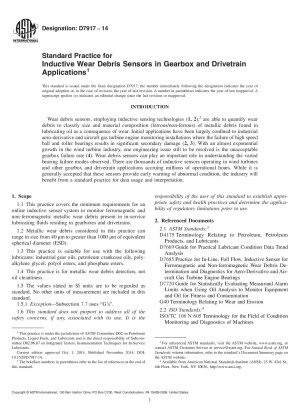ASTM D7917-14
Standard Practice for Inductive Wear Debris Sensors in Gearbox and Drivetrain Applications
- Standard No.
- ASTM D7917-14
- Release Date
- 2014
- Published By
- American Society for Testing and Materials (ASTM)
- Status
- Replace By
- ASTM D7917-14(2018)
- Latest
- ASTM D7917-14(2018)
- Scope
5.1 This practice is intended for the application of online, full-flow, or slip-stream sampling of wear debris via inductive sensors for gearbox and drivetrain applications.
5.2 Periodic sampling and analysis of lubricants have long been used as a means to determine overall machinery health. The implementation of smaller oil filter pore sizes for machinery has reduced the effectiveness of sampled oil analysis for determining abnormal wear prior to severe damage. In addition, sampled oil analysis for equipment that is remote or otherwise difficult to monitor or access is not always sufficient or practical. For these machinery systems, in-line wear debris sensors can be very useful to provide real-time and near-real-time condition monitoring data.
5.3 Online inductive debris sensors have demonstrated the capability to detect and quantify both ferromagnetic and non-ferromagnetic metallic wear debris (1, 2). These sensors record metallic wear debris according to size, count, and type (ferromagnetic or non-ferromagnetic). Sensors can be fitted to virtually any lubricating system. The sensors are particularly effective for the protection of rolling element bearings and gears in critical machine applications. Bearings are key elements in machines since their failure often leads to significant secondary damage that can adversely affect safety, operational availability, operational/maintenance costs, or combinations thereof.
5.4 The key advantage of online metallic debris sensors is the ability to detect early bearing and gear damage and to quantify the severity of damage and rate of progression toward failure. Sensor capabilities are summarized as follows:
5.4.1 Can detect both ferromagnetic and non-ferromagnetic metallic wear debris.
5.4.2 Can detect 958201;% or more of metallic wear debris above some minimum particle size threshold.
5.4.3 Can count and size wear debris detected.
5.4.4 Can provide total mass loss.
Note 1: Mass is an inferred value which assumes the debris is spherical and made of a specific grade of steel.
5.4.5 Can provide algorithms for RUL warnings and limits.
5.5 Fig. 1 (5) presents a widely used diagram to describe the progress of metallic wear debris release from normal to catastrophic failure. This figure summarizes metallic wear debris observations from all the different wear modes that can range from polishing, rubbing, abrasion, adhesion, grinding, scoring, pitting, spalling, and so forth. As mentioned in numerous references (
ASTM D7917-14 Referenced Document
- ASTM D4175 Standard Terminology Relating to Petroleum Products, Liquid Fuels, and Lubricants
- ASTM D7669 Standard Guide for Practical Lubricant Condition Data Trend Analysis
- ASTM D7685 Standard Practice for In-Line, Full Flow, Inductive Sensor for Ferromagnetic and Non-ferromagnetic Wear Debris Determination and Diagnostics for Aero-Derivative and Aircraft Gas Turbine Engine Bearing
- ASTM D7720 Standard Guide for Statistically Evaluating Measurand Alarm Limits when Using Oil Analysis to Monitor Equipment and Oil for Fitness and Contamination
- ASTM G40 Standard Terminology Relating to Wear and Erosion
ASTM D7917-14 history
- 2018 ASTM D7917-14(2018) Standard Practice for Inductive Wear Debris Sensors in Gearbox and Drivetrain Applications
- 2014 ASTM D7917-14 Standard Practice for Inductive Wear Debris Sensors in Gearbox and Drivetrain Applications

Copyright ©2024 All Rights Reserved